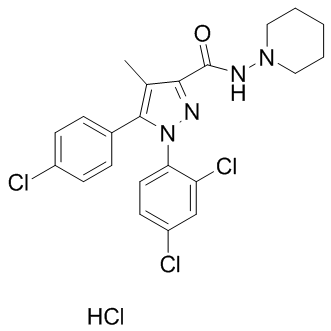| Cas No.: | 158681-13-1 |
| Chemical Name: | 5-(4-chlorophenyl)-1-(2,4-dichlorophenyl)-4-methyl-N-piperidin-1-ylpyrazole-3-carboxamide |
| Synonyms: | Rimonabant free base, SR141716; SR 141716; SR-141716; A 281; A-281; A281; Rimonabant, Acomplia, Zimulti |
| SMILES: | CC1=C(C2=CC=C(Cl)C=C2)N(N=C1C(NN3CCCCC3)=O)C4=C(Cl)C=C(Cl)C=C4.Cl |
| Formula: | C22H21Cl3N4O |
| M.Wt: | 463.787 |
| Sotrage: | 2 years -20°C Powder, 2 weeks 4°C in DMSO, 6 months -80°C in DMSO |
| Description: | Rimonabant hydrochloride is a cannabinoid receptor (CB) antagonist which binds selectively to CB1 with a Ki of 2 nM. |
| In Vivo: | Pretreatment with Rimonabant hydrochloride (SR 141716A) blocks the antinociceptive, discriminative stimulus, memory impairing and hypolocomotor effects produced by Δ-9-THC. SR 141716A also precipitates a withdrawal syndrome in rats treated chronically with Δ-9-THC[1]. Pretreatment of mice with 0.1 mg/kg of WIN 55212-2 is effective in increasing the CPP induced by MDMA , while 1 mg/kg of Rimonabant specifically blocks CB1 receptors and does not act as an inverse agonist[3]. |
| In Vitro: | Rimonabant hydrochloride (SR 141716A) binds selectively to central cannabinoid receptors (CB1) with high affinity (Ki=2 nM), and blocks the inhibitory effects of cannabinoid receptor agonists in the mouse vas deferens, dopamine-stimulated adenylyl cyclase and WIN 55212-stimulated GTPγS binding[1]. Rimonabant dose-dependently inhibited CO synthesis in Raw 264.7 macrophages, with 1 µM producing a significant (~40%) decrease compared to untreated controls and concentrations ≥ 5 µM producing near complete inhibition. A small, but significant, reduction of TG and DG synthesis is also observed with Rimonabant at concentrations ≥ 10 µM. Inhibition of CO synthesis in Raw 264.7 macrophages by Rimonabant (IC50 value 2.9±0.38 µM) is very similar to that of AM251 and SR144528 (IC50 value 2.6±0.26 µM and 2.5±0.32 µM, respectively), two related compounds previously demonstrated to be potent ACAT inhibitors. Mouse peritoneal macrophages also displayed significantly reduced CO synthesis in response to Rimonabant treatment. Rimonabant at concentrations ≥ 1 µM significantly inhibits CO synthesis in CHO-ACAT1 and CHO-ACAT2 cells in a concentration-dependent manner with similar efficiency (IC50s of 1.5±1.2 µM and 2.2±1.1 µM, respectively)[2]. |

 DC Chemicals' products qualify for U.S. tariff exemptions. We guarantee no price increases due to customs duties and maintain stable supply, continuing to deliver reliable research solutions to our American clients.
DC Chemicals' products qualify for U.S. tariff exemptions. We guarantee no price increases due to customs duties and maintain stable supply, continuing to deliver reliable research solutions to our American clients.





















